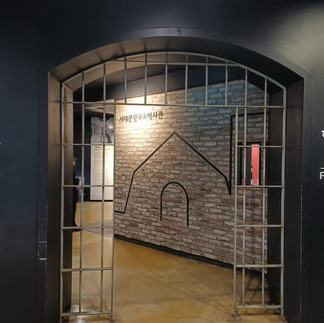Seodaemun Prison History Hall
The former prison, now a museum, offers a reminder that the Republic of Korea has a turbulent history, which is encapsulated within the walls of Seodaemun Prison History Hall. The prison museum offers a poignant reminder of the hardships endured by the Korean people throughout the Japanese occupation and the subsequent struggles for democracy. The contrast between the serene exterior of the prison, nestled within parkland, and the grim history it holds is striking.
For K Drama fans, the Netflix series, Gyeongseong Creature, with Park Seo Joon, although fictional, has some historical content at its base. Japan annexed the Korean peninsula in 1910 until 1945. Gyeongseong Creature is set roughly six months before Japan’s surrender, when the majority of Koreans lived miserably and subjected to an aggressive assimilation project under the ‘naisen ittai’ with extraordinary rules imposed, censorships and loss of freedom, and many women and girls forced into sexual slavery as ‘comfort girls’ for the Japanese.
This tour is not for the faint hearted. It is emotional and thought provoking, much like the concentration camps of Europe. And to those of us (🖐 guilty) who fantasise about this country as being full of romantic palaces with an ‘oppa’ or crown prince just around the corner of that cherry blossom tree, then this is a sobering wake-up call.

Seodaemun Prison was constructed in 1908 and completed during the Japanese occupation of Korea. Its original purpose was to detain and suppress Korean independence activists. The harsh conditions and brutal treatment of prisoners, including torture and executions, reflect the severe repression faced by those who opposed colonial rule. The prison continued to be used even after the end of Japanese occupation in 1945, during the periods of military rule in South Korea, further symbolising the struggle for democracy.
Throughout the museum hall, various information boards, photographs, and visual models vividly depict the torture, incarceration, and daily lives of the prisoners. These exhibits cover the period from the prison's inception in 1908 through the end of Japanese rule in 1945 and the later years of internal conflict up to 1987.
The Main Building is built of imposing brick and housed numerous political prisoners. Its architecture is a stark reminder of the oppressive environment in which it operated; the Execution Building, a graphic reminder of the grim reality faced by those who were executed. It is a sombre place where visitors can reflect on the ultimate sacrifice made by many. But even more harrowing is the Corpse Removal Room. This exhibit highlights the brutal aftermath of executions, providing a chilling insight into the treatment of prisoners.
Newer additions to the prison since its closure are the Reverence Monument and the Freedom Fighters Memorial. The Reverence Monument honours the memory of all who suffered and died in Seodaemun Prison and is a place for reflection and remembrance, while the Freedom Fighters Memorial is in remembrance of over 40,000 individuals who were imprisoned at the site, and the more than 7,000 that were either executed or tortured to death. This area pays tribute to their courage and resilience.
Visiting the Seodaemun Prison History Hall is a deeply moving experience that offers invaluable historical insights. It is an essential stop for anyone interested in understanding Korea's fight for freedom and the high price paid by many for the country's independence and democratic values.
Recently, the National Heritage Administration's initiative to offer free admission from May 15-19 has encouraged a broader audience to engage with this significant part of Korean history. This effort has resulted in a diverse turnout, including families, school groups, and individuals of all ages, fostering a deeper appreciation and awareness of Korea's historical struggles.
While Korea is often admired for its cultural heritage, modern advancements, and scenic beauty, this raw, unfiltered presentation of the prison's past, from the torture and execution of freedom fighters to the oppression during military rule, serves as a powerful testament to the resilience and courage of those who fought for Korea's independence and democratic future. It is a sobering reminder of the country's tumultuous journey and serves as a stark reminder that the freedom and democracy enjoyed today were hard-won through immense suffering and bravery.
Seodaemun Prison History Hall is not merely about learning historical facts; it's about connecting emotionally with the past and recognizing the indomitable spirit of the Korean people and ensuring that such histories are remembered and learned from.

I did find the need afterwards to wander in the rain reflecting on the history I had just learnt, much in the same way as I felt after visiting Anne Frank’s home in Amsterdam, or Auschwitz, and found my way to Fried Chicken….comfort food and a hot drink were definitely needed while I reflected on the past.







